How to replace a lawn mower starter rope
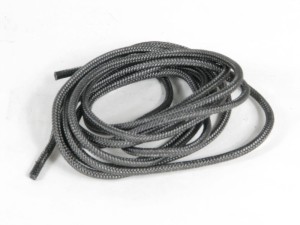
This DIY lawn mower repair guide has instructions for how to replace a lawn mower starter rope. Over time, the starter rope can wear out and eventually break, and the mower won't start. You can replace a broken recoil starter rope with a manufacturer-approved replacement part by following the steps below.
Use these steps to replace the recoil starter rope on common Briggs & Stratton engines that power Craftsman, Toro, MTD, Troybilt, Husqvarna, Cub Cadet and Poulan walk-behind lawn mowers.
Instructions
- 01.
Disconnect the spark plug wire
Wear work gloves to protect your hands.
Disconnect the spark wire so there's no chance that the mower could accidentally start.

PHOTO: Disconnect the lawn mower spark plug wire.
- 02.
Remove the starter rope from the guide
Remove the starter rope from the rope guide.
If the rope won't slip past the guide and the handle, loosen the guide.
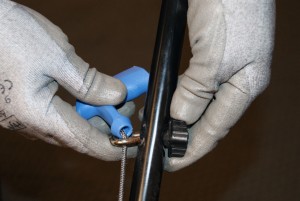
PHOTO: Remove the starter rope from the guide.
- 03.
Remove the engine cover
Remove the screws securing the engine cover to the engine.
Slide the rope through the hole in the engine cover.

PHOTO: Remove the engine cover.
- 04.
Remove the fuel tank
Remove the screws that secure the fuel tank to the engine.
Lift the tank off, being careful to keep the fuel tank upright so it doesn't leak.
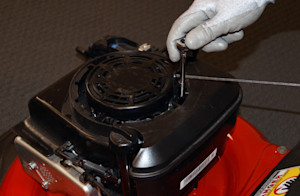
PHOTO: Remove the fuel tank.
- 05.
Remove the dipstick tube
Remove the screw that secures the dipstick tube to the housing.
Remove the dipstick tube from the engine and plug the hole with a paper towel to keep debris from falling into the engine.
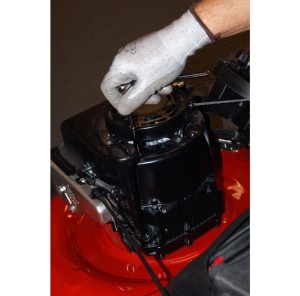
PHOTO: Remove the dipstick tube.
- 06.
Remove the engine blower housing
Remove the bolts securing the blower housing to the engine and remove the housing from the engine.
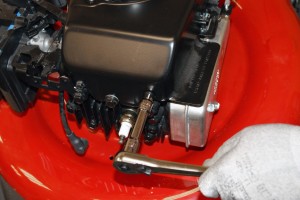
PHOTO: Remove the blower housing.
- 07.
Rewind the recoil spring
Inspect the starter pulley and remove any remaining starter rope.
Turn the rope pulley counter-clockwise 7 times to wind the spring. Align the hole in the pulley with the hole in the housing and insert a screwdriver through the holes to keep them aligned as you work.
- 08.
Thread the rope through the pulley
Thread the new rope through the hole in the housing and pulley. Tie a knot in the rope to keep it from slipping out of the pulley.
- 09.
Attach the rope to the starter handle
While holding the rope, remove the screwdriver from the holes in the pulley and housing, and let the rope slowly rewind.
Attach the other end of the rope to the starter handle. Feed the rope through the hole in the handle and secure it with another knot.
- 10.
Reassemble the mower
Position the engine blower housing on the engine and bolt it into place.
Remove the paper towel from the dipstick opening, slide the dipstick tube into the engine and secure it with the screw.
Feed the starter rope handle through the engine cover up to the rope guide.
Reinstall the fuel tank.
Position the engine cover on the engine and screw it into place.
- 11.
Reconnect the spark plug wire
Attach the spark plug wire and make sure the mower works properly.
Symptoms for gas walk-behind mowers
Choose a symptom to see related walk-behind mower repairs.
Main causes: engine needs tune up, dirty or clogged carburetor, damaged flywheel key…
Main causes: uneven wheel height settings, damaged wheel, dull or damaged cutting blade…
Main causes: damaged cutting blade, loose cutting blade, damaged flywheel key, engine needs tune up…
Main causes: stale gas, engine needs tune up, bad spark plug, dead battery, bad recoil starter, faulty safety switch, ba…
Main causes: dirty carburetor, bad spark plug, clogged air filter, engine choke problems, clogged gas cap vent…
Main causes: drive control cable failure, worn or broken drive belt, bad transmission, broken drive wheel…
Repair guides for gas walk-behind mowers
These step-by-step repair guides will help you safely fix what’s broken on your walk-behind lawn mower.
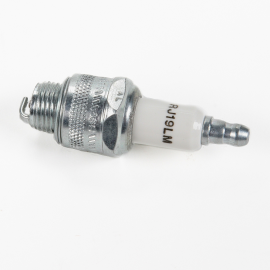
How to replace a lawn mower spark plug
Take a few minutes to replace the spark plug during your lawn mower's annual tune-up or if the spark plug is burnt or cr…

How to replace a lawn mower blade
Check your lawn mower blade regularly and replaced it if it's bent or damaged. …
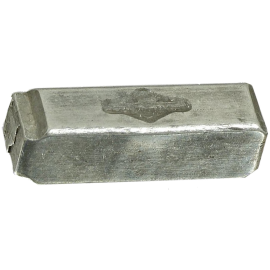
How to replace a lawn mower flywheel key on a flathead engine
When you hit a hard object with your mower, the flywheel can shear to protect more expensive components. Learn how to re…
Effective articles & videos to help repair your walk-behind mowers
Use the advice and tips in these articles and videos to get the most out of your walk-behind lawn mower.

Learn about all the convenient features on our Sears PartsDirect website that make your parts purchases easier.…
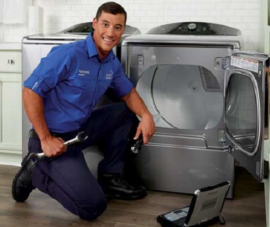
Learn about Sears Technical Institute and the advanced technical content being developed for aspiring appliance techs.…

Get answers to frequently asked questions about Sears and Sears PartsDirect.…